Table of contents
- Tires for large travel enduros in the test There is the universal tire?
- The ultimate tire for the BMW r 1200 GS?
- Touring model tailored to road sports
- Enduro tires ex works
- Continental TKC 70 up to 240 km / h
- This is how MOTORRAD tests
- Country roads and highways
- Brake measurement from 100 km / h
- Conclusion
- terrain
- Acceleration measurement uphill
- Full braking downhill in the terrain
- Conclusion
- Wetness test
- Brake measurement in wet conditions
- Conclusion
- Test candidates
- Continental TKC 70
- Continental TKC 80
- Dunlop Trailsmart
- Metzeler Karoo 3
- Michelin Pilot Road 4 Trail
- Final scoring

markus-jahn.com

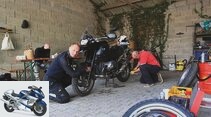
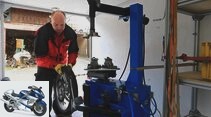
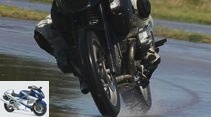
28 pictures
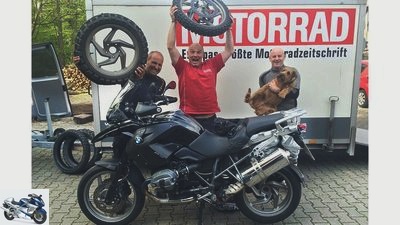
markus-jahn.com
1/28
Whether with a growling boxer or a yapping terrier: the MOTORRAD tire test causes the big tremors in the rubber scene every year.
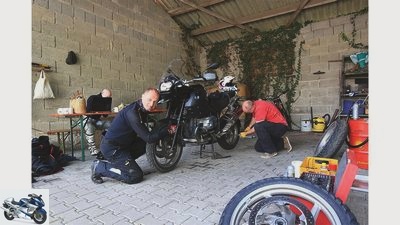
markus-jahn.com
2/28
There wasn’t just a lot to do on the bike, …
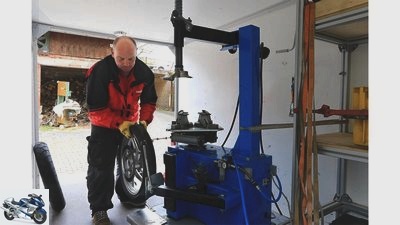
markus-jahn.com
3/28
… Regular tire changes were also part of the test.

markus-jahn.com
4/28
Next discipline: The tires have to prove themselves on a wet road.
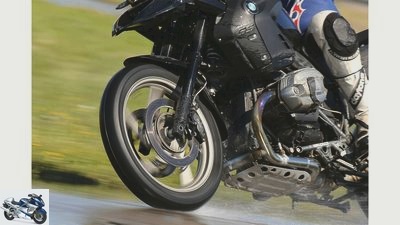
markus-jahn.com
5/28
It’s not the profile, but the mixture that counts in the wetness test.
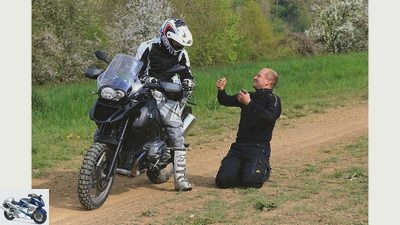
markus-jahn.com
6/28
So which tire, all in all, wins the race? We clarify.
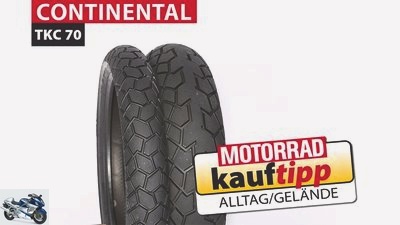
markus-jahn.com
7/28
In terms of stability, the TKC 70 has to be clearly behind Trailsmart and Road 4 Trail. But if you want a great mix of road and off-road performance, you can choose this Conti.
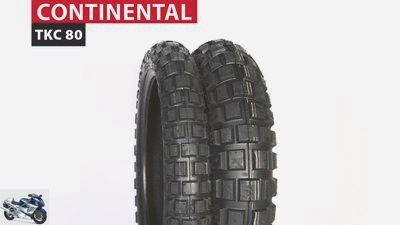
markus-jahn.com
8/28
The tire for the Barney Rubble among GS riders. In the off-road heaven, the TKC 80 is still fresh as a dew even after 30 years. But hands off in road use on powerful large enduros.
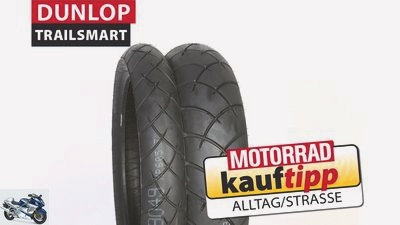
markus-jahn.com
9/28
Measured against the performance (and weight) that modern large enduro bikes are now bringing to the road, the Trailsmart delivers the appropriate rims. Best choice for everyday GS.

markus-jahn.com
10/28
Not fish, not meat. Metzeler’s Grobstoller cannot really distinguish itself in this comparison of concepts. The TKC 80 is better off-road and remains restrained on the road.
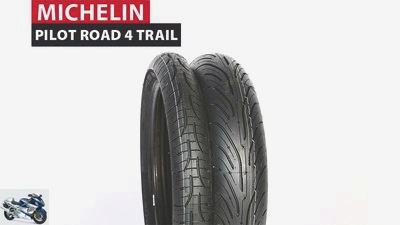
markus-jahn.com
11/28
The Road 4 is also a clear case for the road as a trail version. If you are only on the road, you can pull it up without hesitation. But not if you still want an off-road option.
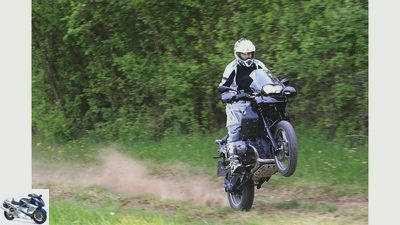
markus-jahn.com
12/28
Obviously, depending on the intended use, the best tires are different.
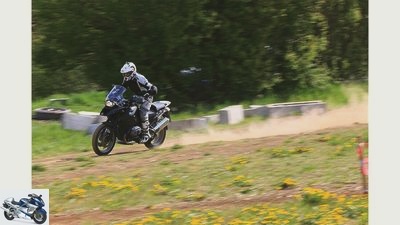
markus-jahn.com
13/28
But our tip for anyone looking for a good mix of both worlds is TKC 70. The Conti, which was newly introduced in 2014, appeals on the road and in easy terrain.

markus-jahn.com
14/28
… dusty slopes. It goes without saying that the bigger tires do better here.
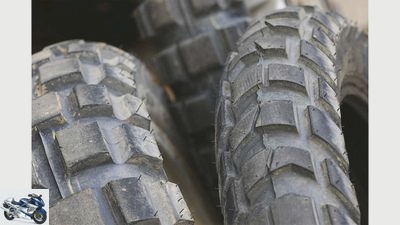
markus-jahn.com
15/28
If the tires you want have not been rolled up for this test, simply take a look at our online archive at www.motorradonline.de/reifentest.

markus-jahn.com
16/28
The BMW R 1200 GS is the most popular motorcycle in Germany.
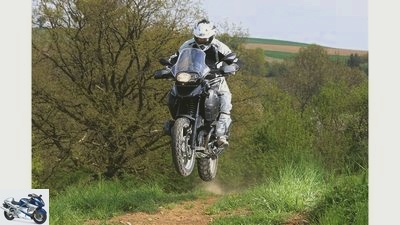
markus-jahn.com
17/28
That is why we use them as a substitute for the class of large travel enduros in this test.
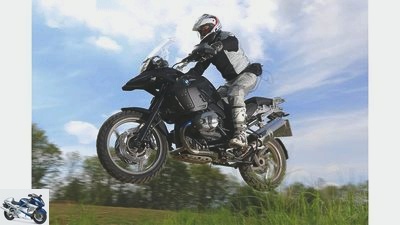
markus-jahn.com
18/28
The Gs are chased over dusty slopes, but with their enduro genes they also have to take part in smaller jumps.

markus-jahn.com
19/28
Country roads in particular are considered the most popular area for large travel enduros like the BMW R 1200 GS.
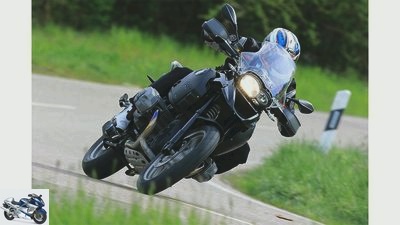
markus-jahn.com
20/28
Of course, all candidates had to show what they can do in the test.
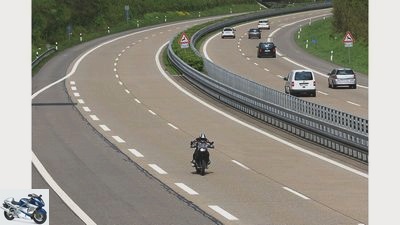
markus-jahn.com
21/28
Actually atypical for enduro, but not rarely in practice: Enduros on motorways. That’s why we test the tires on these roads too.
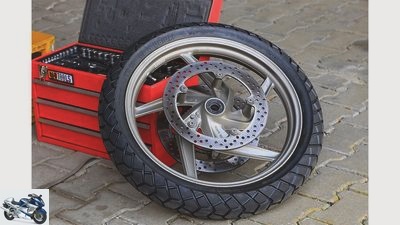
markus-jahn.com
22/28
Our concept comparison aims to find out which tire masters all of these disciplines best.
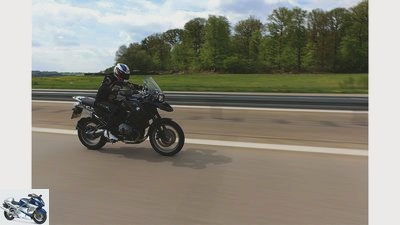
markus-jahn.com
23/28
Let’s start with the Autobahn …
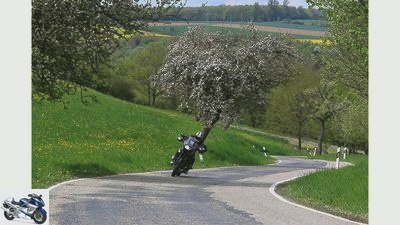
markus-jahn.com
24/28
… and country road.
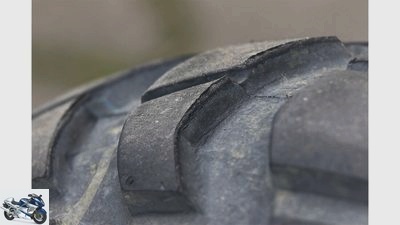
markus-jahn.com
25/28
Significant edge wear on the Karoo 3: Only a few emergency stops were enough to take this photo.
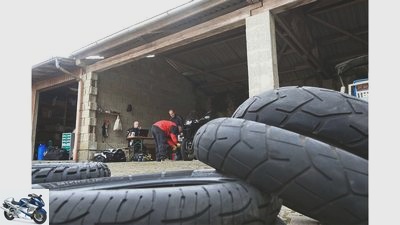
markus-jahn.com
26/28
The next discipline is on …

markus-jahn.com
27/28
… the site.
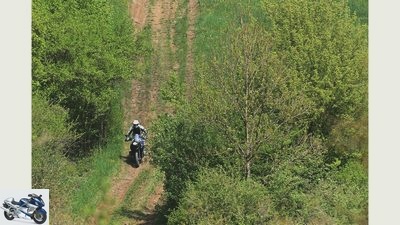
markus-jahn.com
28/28
Loose ground, …
accesories
tire
GS class tires tested
Tires for large travel enduros in the test
There is the universal tire?
How good are the studded tires for travel enduros à la BMW R 1200 GS & Co on the street? Which tire is best for the road? Even when it is wet? And which tire is the all-rounder for big travel enduros?
Jorg Lohse, Karsten Schwers
06/25/2015
In the meantime, the customs scene also has the tire legend Continental TKC 80 discovered for itself. There is hardly a youngtimer bobber that can do without the TKC 80 as a rim decoration. And thanks to the 17-inch version with 180/55 rear tires that is now available, many a 200-hp superbike has already been converted to the coarse cleat.
Buy complete article

Tires for large travel enduros in the test
There is the universal tire?
10 pages) as PDF
€ 2.00
Buy now
Was that it, the proud companion of tens of thousands of deserters, jungle fighters and bush pilots degenerated into a profane boulevard cruiser and a shrill decorative object in front of the ice cream parlor? In the third part of our tire test, we wanted to know more about it and asked the tire, which had the H license plate maturity in terms of vehicle technology, to exchange blows with a partly much younger test field: Continental TKC 80 against Continental TKC 70 Dunlop Trailsmart, Metzeler Karoo 3 and Michelin Pilot Road 4 Trail.

tire
6 pairs of touring tires in the test
Touring tires on Suzuki GSX-S 750
read more
The ultimate tire for the BMW r 1200 GS?
The question at our virtual MOTORRAD get-togethers: Is there actually the ultimate tire for the Germans’ favorite motorcycle, BMW’s R 1200 GS? Since the air-cooled version with the tire dimensions 110/80 R 19 at the front and 150/70 R 17 is represented in the vehicle fleet well before the water-cooled model with the wide tires, we opted for the last generation of the K25 series. BMW dealer Karl Maier from Neufinsing contributed a 2013 R 1200 GS “Triple Black” from its inventory, now all that was missing was the appropriate tires.
The classic car mentioned at the beginning was of course set. Like no other tire, the TKC 80 has accompanied the development of the GS series. It is logical that it should not be missing in the concept comparison. Before we get down to the nitty-gritty, however, for a better understanding it should be added that the 30 years have of course not left the TKC 80 without a trace.
Outwardly, a lot may have remained the same, but in addition to the already mentioned expansion of the dimensions, the rubber compounds have been adapted accordingly over the years. And even if Conti’s advertising slogan is “German technology since 1871”: The TKC 80 has been manufactured by Shin Hung in South Korea, the manufacturer of Shinko tires, since 2005 (see MOTORRAD 12/2014). Against whom does the gross stoller have to compete??
Touring model tailored to road sports
Of course it is clear that only a fraction of the GS riders actually dig their way through the dirt. The boxer is mostly driven on the street. Which is why each of the well-known tire manufacturers now offers a touring model that is geared towards road sport, also in (old and new) GS dimensions.
Our choice for this test was the Michelin Pilot Road 4, which is available in a special trail version for enduros. Like the standard and GT version, the Road 4 Trail is designed as a multicompound tire. In plain language this means that the rubber compound consists of treads of different hardness. Front and rear, the center of the tire is harder for the purpose of higher mileage. The soft compound on the tire shoulders, on the other hand, is supposed to build more grip in corners.
In terms of construction, the trail version differs from the standard and Road 4 GT only through a differently coordinated rubber compound. Visually, the trail also follows the Road 4 sister models; Michelin has dispensed with a robust off-road look. We have now set the counterpoint to the TKC 80. There is no more road than the Road 4 Trail. Now it is time to fill the space in between.
Enduro tires ex works
Travel enduros like the BMW are ex works R 1200 GS equipped with so-called enduro tires. Mainly they are tailored to the road, but wider carved tread grooves should add a pinch of off-road suitability. For this concept comparison, we have nominated the Dunlop Trailsmart, which is new for this season.
And quite successfully: In part two of our tire test (in Edition 13/2015) the Dunlop presented itself as a consistently convincing tire in terms of performance. In the final balance, only the new enduro tire from Pirelli (Scorpion Trail II) was able to hold its own better and pushed Dunlop to second place.
At this point, of course, the objection is justified: Why not nominate the Pirelli test winner for this concept comparison? Counterattack from the MOTORRAD regulars table: brand proportionality! Because from the Pirelli Group, which also includes the brand Metzeler heard, we really wanted to include the Metzeler Karoo 3 in this comparison. The significantly coarser sister model of the well-known Tourance Next enduro tire is considered by many GS riders to be a secret weapon for off-road use, but it should still work well on the road. The Karoo 3 with the classic 50:50 distribution for road and terrain, which in theoretical terms is more or less the golden mean. Should it prove to be the ideal on the GS rim?
In any case, this would make sense to fill the test field for this concept comparison: the legendary hardcore studded animal called Conti TKC 80, a well-balanced on / off-roader called Metzeler Karoo 3, the typical enduro tires in the form of the Dunlop Trailsmart and as pure road tires in GS trim the Michelin Road 4 Trail.
Continental TKC 70 up to 240 km / h
Wait, let’s throw a wildcard into the race in our round of regulars and give the grandpa a perky grandson in the test field. Conti has had the TKC 70 in its range since 2014. In contrast to the coarse-tread grandfather with a diagonal construction, the young sister model is again manufactured in Germany as a radial tire. In terms of construction, the TKC 70 is more likely to be based on the Enduro Trail Attack 2 profile, but some key data shows the kinship to the TKC 80. The 70s also has the M + S identification, which makes it attractive for winter drivers.
The driver does not have to accept the 80s speed limit (speed index Q = 160 km / h). Thanks to the V-Index, the TKC 70 can be driven at speeds of up to 240 km / h. The profile picture is not quite as rough as the TKC 80, but the striking block design speaks for possible off-road qualities. At the same time, a multicompound-like rubber compound with an abrasion-resistant center and soft, high-grip shoulder areas should get the most out of the road.
Reason enough to briefly throw the brand proportional overboard at this point and nominate another Conti for the comparison with the TKC 70. Thank goodness, our regulars’ table brothers could throw in now when the final bill flutters onto the counter. Because the TKC 70 can really convince.
It keeps up with the street faction, but still provides sufficient traction off-road. Road riders, on the other hand, feel particularly comfortable on the Trailsmart – the slightly crumple enduro tires on the GS chassis provide better feedback than the relatively stiff touring tires à la Road 4 Trail. The Karoo 3, on the other hand, remains a bit pale. If you really only go on off-road slopes, you should grab the TKC 80 right away. If it is gross stutter, then do it right! Finally, let’s toast the original with a toast …
This is how MOTORRAD tests
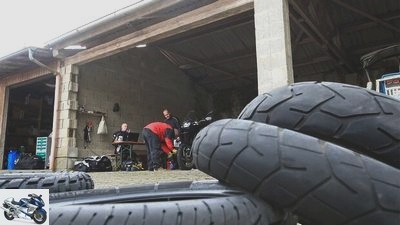
markus-jahn.com
The test runs both on and off the road.
As in the second part (Enduro tire test) the tires for this concept comparison roll on an (air-cooled) 2013 BMW R 1200 GS. Country road and motorway performance were measured in the Jagsttal near Heilbronn. The off-road course for the off-road test was also located there. The wet test took place on the Michelin test area near Salon-de-Provence (France).
And these are our test parameters:
Handiness …
… is the steering force to tilt the machine and to keep it in line in alternating curves.
Liability / acceleration … *
… describes the lateral guidance and power transmission in corners of different speeds (wet / dry).
Steering precision … *
… in passages of different speeds with complicated curve radii. Provides information about whether the motorcycle is following the desired course, which is specified by the steering forces, or whether clear line corrections are required.
Borderline behavior … *
… stands for the controllability of the tire at the limit. On wet and dry roads as well as off-road.
Cornering stability …
… tests the build-up in (alternating) curves and on bumps. Is tested in different modes (solo / with pillion passenger) and in a great lean angle when accelerating.
Liability / inclination … *
… is the lateral guidance in maximum incline on wet and dry asphalt as well as off-road. A tightrope walk that is only possible on a closed route.
Straight-line stability …
… is tested at high speed. Does the motorcycle remain stable on course or does the commuting disrupt the journey??
Setup moment …
… refers to straightening up when braking in an inclined position. This reaction must be balanced out with a counterforce (pressure) on the inside of the handlebar end.
Filling pressure in the test
2.2 bar at the front, 2.5 bar at the rear.
* The sections marked with an asterisk can be transferred to motorcycles that have a similar geometry to the BMW R 1200 GS shown.
Country roads and highways
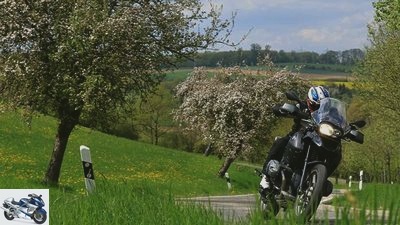
markus-jahn.com
How far are the coarse tires actually from road-optimized enduro tires? Our test found that out.
Large enduro bikes are usually equipped ex works with the classic enduro profiles that we use in Part 2 of our this year’s tire test. At the latest with the first change, the question arises: More coarse studs or the fine black one for the road? There is no doubt that the majority of modern enduro bikes are driven almost without exception on paved slopes. Gravel usually only gets under the wheels when it comes to the roadside for a pee break. So you could just go for a 100 percent (touring) road tire, which is offered by almost every manufacturer in the typical 110/80 and 150/70 enduro format. Sometimes even with a corresponding additional designation. For example, Michelin offers the Road 4 touring tire in three versions: in a normal version, additionally reinforced as a Gran Turismo or as a trail tire with a rubber compound tailored to enduro bikes.
Those who have tires going in the other direction – i.e. for more off-road performance – naturally want to know how much losses they have to accept on country roads and on motorway journeys. Comfort deductions can already be felt directly with the popometer on larger-tread GS tires such as the classic Conti TKC 80 or Metzeler’s 50/50 profile (road / terrain), but there are also reliable test values?
Brake measurement from 100 km / h
A brake measurement from 100 km / h under ideal conditions makes it clear where the dangers of the gross scooter lurk. Despite excellent support from the ABS brake assistant, the GS with TKC 80 or Karoo 3 tires needs extremely long braking distances with significantly higher residual speeds.
Conclusion
Of course, this result would have already been clear after a relaxed round table discussion. However, this test provides a clear indication of how far the gross scooters are actually from the road-optimized enduro tires. One should not have any illusions about behavior in the border area. Here the performance of the Contis TKC 80 and Metzeler’s Karoo 3 is more than modest and demands an experienced driver on powerful large enduro bikes. However, Conti’s newly introduced TKC 70 is particularly positive, as it is able to connect to road tires despite the rough profile.
terrain
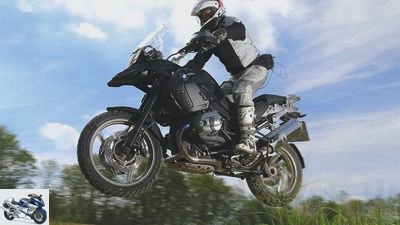
markus-jahn.com
The Gs are chased over dusty slopes, but with their enduro genes they also have to take part in smaller jumps.
Watt is a steam engine? Analogous to the question of high school professor Bommel in the “Feuerzangenbowle” one would first have to clarify in this test section: Watt is en Jelandefahrt? If you were to ask ten motorcyclists what they classify under the heading “Offroad”, you would probably get eleven different points of view. For some it is the nature pass in the Alps, for others the off-road ride only begins with a juicy jump on the table of a cross piste. Merge a combination of these two extremes into a crisp test round? That doesn’t seem expedient. On the one hand, graveled alpine paths can also be driven on with the standard tires of a cruiser, on the other hand, the heavy-weight, large enduros à la R 1200 GS are not intended for robust motocross inserts. Even with a harmless jump passage (the photo above looks more spectacular than it actually is!) The spring elements of the GS are easily overwhelmed.
Acceleration measurement uphill
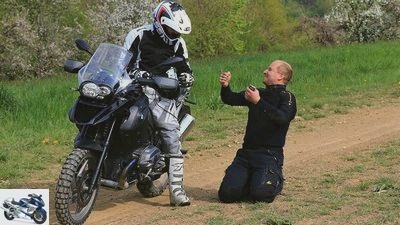
markus-jahn.com
Uphill acceleration measurement with the BMW R 1200 GS.
Our choice: the golden mean! All five candidates in our concept comparison had to prove their off-road capabilities on sandy and loamy forest and meadow paths as well as on a dusty off-road oval. First practical test: When measuring uphill acceleration on a loamy dirt road, the traction capacity of the test subjects is to be poured into measured values. It quickly becomes clear that the TKC 80 is here in its territory and also has the tough competition from the same stable (TKC 70) and from Metzeler (Karoo 3) in their place. However, the result in the back two places is astonishing. Looking at the profile, Dunlop’s enduro tire Trailsmart would have been given more traction than the smoothly profiled Michelin Pilot Road 4 Trail road tire. Data recording speaks a different language. Michelin beats the Dunlop by a split second!
Full braking downhill in the terrain
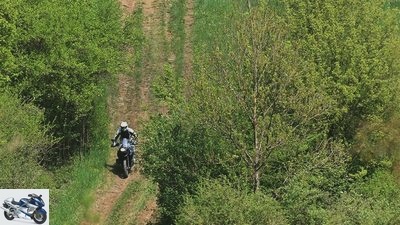
markus-jahn.com
MOTORRAD top tester Karsten Schwers puts all tires to the test, even off-road.
Second exercise on the same passage. Full braking, but this time in the opposite direction – that is, downhill. Woe if the front wheel cannot interlock properly in loose ground in this section. Then there is a risk of a fall despite the ABS. Surprisingly, the Trailsmart can follow the much more coarsely structured surfaces of the Michelin and the two Conti tires. In contrast, the Michelin profile clogs very quickly, which is why the GS-ABS accompanies the downhill stoppie with most of the control processes. The result is around five meters more travel than with the Conti TKC 80.
At the end of an almost 300 meter long, sandy-loamy oval: Accelerate, brake, turn. Here it is important to sound out the adhesion in an inclined position and the behavior in the limit area. Also clear that the TKC 80 dominates this exercise. But our MOTORRAD regulars’ table now knows exactly with which values.
Conclusion
With Grandpa Conti, real rock ’n’ roll is still the order of the day in this test field. Even after 30 years of construction, the TKC 80 has clearly more modern competitors in their place. Overall, however, the Metzeler Karoo 3 operates at eye level. Conti’s new development, the TKC 70, follows at a slight distance. Overall, however, its off-road performance is still impressive. The classic enduro tire in this test field, Dunlop’s new Trailsmart, on the other hand, quickly reached the limit in the field, and Michelin’s Road 4 remains a pure road tire despite the trail design.
Wetness test

markus-jahn.com
Are you planning to ride your motorcycle in the rain? Only a few do it, but we all drive on wet roads every now and then.
The assessment of rain performance is one of the standards in every MOTORRAD tire test. Even if you prefer to be out and about on two wheels in the sunshine: at some point you will suffer a shipwreck or a cloudburst on the most beautiful tour. It’s good when you can rely on rubber with good grip even on wet asphalt. Before the tangible measured values, as in the previous chapters, let’s go to the virtual MOTORRAD get-togethers and debate the possible end result. One could assume that the wide negative grooves of the coarse tollers ensure good water displacement and are therefore ahead in the rain. The classification of the TKC 80 as a winter tire with M + S identification could also be an indication of good performance on slippery surfaces. Balance at the green table: The rough stokers make the race in the rain.
Brake measurement in wet conditions
In reality, let’s get to the shiny black asphalt and bring the R 1200 GS to a standstill from 100 km / h on a wet road in the incorruptible MOTORRAD brake measurement. Even more impressive than the distances covered are the remaining speeds of the other tires when the best in this test section (Dunlop Trailsmart) is already standing. Because they show very clearly what good rain tires can do. And the classic coarse tugs that rush past the Dunlop GS at well over 40 km / h are definitely not one of them. The permanently watered circuit also shows that TKC 80 and Karoo 3 are anything but safe to drive rain tires.
Conclusion
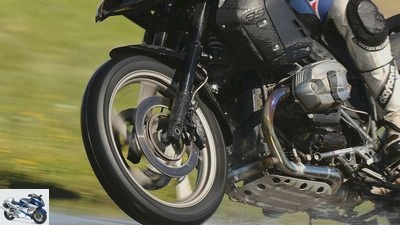
markus-jahn.com
Hypothesis: The rough stokers make the race in the rain.
The profile? No, it’s all in the mix! In order to be able to continue to control the motorcycle well on wet roads, the rubber compound must be matched accordingly. The profile is a minor matter. Michelin has traditionally been ahead of the curve in many tire categories in this test section. It was well known that the Road 4 is an excellent rain tire. The trail version follows this up. Interesting the scramble in second place. Dunlop’s Trailsmart scores on the brakes (better than the Michelin!), Conti’s TKC 70 proves that even rough studs can achieve very good wet test results. At the limit, this Conti shows a convincing performance.
Test candidates
Continental TKC 70
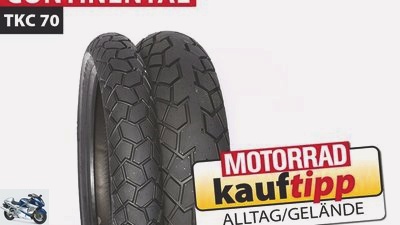
markus-jahn.com
Continental TKC 70
Weight: front 5.0 kg, rear 7.6 kg
Country of Manufacture: Germany
Info / approvals: Continental tires, Tel. 05 11/9 38 01, www.conti-moto.de
Conclusion: In terms of stability, the TKC 70 has to be clearly behind Trailsmart and Road 4 Trail. But if you want a great mix of road and off-road performance, you can choose this Conti.
MOTORRAD verdict: 244 points, 3rd place
Continental TKC 80

markus-jahn.com
Continental TKC 80
Weight: 4.6 kg at the front, 6.6 kg at the rear
Country of Manufacture: South Korea
Info / approvals: Continental tires, Tel. 05 11/9 38 01, www.conti-moto.de
Conclusion: The tire for the Barney Rubble among GS riders. In the off-road heaven, the TKC 80 is still fresh as a dew even after 30 years. But hands off in road use on powerful large enduros!
MOTORRAD verdict: 165 points, 5th place
Dunlop Trailsmart

markus-jahn.com
Dunlop Trailsmart
Weight: front 5.2 kg, rear 7.6 kg
Country of Manufacture: France
Info / approvals: Goodyear Dunlop Tires Germany, Tel. 0 61 81/68 01, www.dunlop.de
Conclusion: Measured against the performance (and weight) that modern large enduro bikes are now bringing to the road, the Trailsmart delivers the appropriate rims. Best choice for everyday GS.
MOTORRAD verdict: 249 points, 1st place
Metzeler Karoo 3

markus-jahn.com
Metzeler Karoo 3
Weight: front 5.2 kg, rear 6.8 kg
Country of Manufacture: Brazil
Info / approvals: Pirelli Germany, Tel. 0 89/14 90 83 02, www.metzelermoto.de
Conclusion: Not fish, not meat. Metzeler’s Grobstoller cannot really distinguish itself in this comparison of concepts. The TKC 80 is better off-road and remains restrained on the road.
MOTORRAD verdict: 179 points, 4th place
Michelin Pilot Road 4 Trail
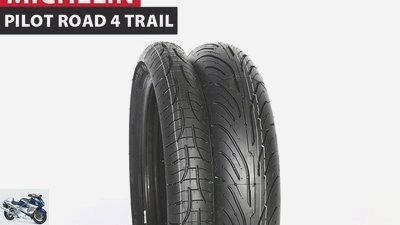
markus-jahn.com
Michelin Pilot Road 4 Trail
Weight: front 5.2 kg, rear 6.4 kg
Country of Manufacture: Spain
Info / approvals: Michelin Reifenwerke, Tel. 07 21/53 00, motorrad.michelin.de
Conclusion: The Road 4 is also a clear case for the road as a trail version. If you are only on the road, you can pull it up without hesitation. But not if you still want an off-road option.
MOTORRAD verdict: 248 points, 2nd place
Final scoring
Let’s roll up the table from back to front. Anyone who is already out and about on loose terrain from the garage will not be able to pass the TKC 80 or Karoo 3. And those who enjoy sun and rain on their GS exclusively on the road will prefer the Trailsmart or Road 4 Trail to their rims. But our tip for anyone looking for a good mix of both worlds is TKC 70. The Conti, which was newly introduced in 2014, appeals on the road and in easy terrain.
Placement by points:
1. Dunlop Trailsmart
2. Michelin Road 4 Trail
3. Continental TKC 70
4. Metzeler Karoo 3
5. Continental TKC 80
Related articles
-
Enduro tires tested 110-80 R 19, 150-70 R 17
markus-jahn.com 34 pictures markus-jahn.com 1/34 Enduro riding … markus-jahn.com 2/34 Especially during the wet test, the GS rolled out with a…
-
Tested off-road tires for large travel enduros
17th pictures Markus Jahn 1/17 The Bridgestone Battlax AX 41 is the tip for off-road-oriented travel endurists. 2/17 Even after more than three decades,…
-
manufacturer accesories tire Guide: new tires being tested Guide: tires New tires put to the test MOTORRAD tested various new tires for enduro, tourers…
-
MOTORRAD tire test 2016 – touring tires
markus-jahn.com 14th pictures markus-jahn.com 1/14 Picture gallery: Touring tires 120/70 ZR 17 and 180/55 ZR 17 in the test. markus-jahn.com 2/14 After…
-
Market overview of new motorcycle tires 2016
markus-jahn.com 28 pictures manufacturer 1/28 Metzeler Racetec RR / Compk Slick: With these two slicks, the super sporty RR family (from M7 RR) should…
-
Enduro tires in the 2013 tire test
Jahn 44 pictures Jahn 1/44 Tire test 2013: 6 pairs of enduro tires: 110/80 R19, 150/70 R17. Jahn 2/44 Six enduro tires in country roads, wet conditions…
-
Enduro tires 120-70 R 19 and 170-60 R 17 in the product test
markus-jahn.com 34 pictures markus-jahn.com 1/34 On the way tip: on towel-wide single tracks through rustic forests, in between winding Carrera tracks,…
-
Touring tires 120-70 ZR 17, 180-55 ZR 17 in the test
markus-jahn.com 58 pictures markus-jahn.com 1/58 In the wet test, the tires beat quite differently. markus-jahn.com 2/58 Givi holding system “Tanklock”:…
-
Test winner tire test part 2 – Enduro tires (MOTORRAD 13-2015)
mps studio accesories tire Test winner tire test part 2 – Enduro tires (MOTORRAD 13/2015) Test winner tire test part 2 – Enduro tires (MOTORRAD 13/2015)…
-
Sports tires 120-70 ZR 17 and 190-55 ZR 17
Jahn 49 pictures Jahn 1/49 Johannes Muller (30), MOTORCYCLE intern: As the youngest, he moves the oldest iron: CB 750 Four. Jahn 2/49 Lock-it tank bag…